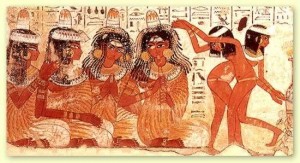During the ancient Egyptian period, dancing (Egyptian Dancers) formed an important part of the lives of the people. At the time of Old Kingdom rule, dance has performed a pair of men. People belonging to all social classes were open to dancing as a form of entertainment. Dancing was associated with religious ceremonies alone during the early period.

In the ancient times, dance troupes were performed at evening parties, banquets and even in religious temples. Women of the harems danced for royalty and along with these women were the female musicians who played instruments like guitars, lyres, and harps.
Other instruments used were drums, lutes, flutes, cymbals, and tambourines. Men and women danced with clappers. Although dancing was a source of entertainment to all the classes, no well- bred Egyptian danced in public. The wealthy classes kept slaves who entertained them as they pleased.
During the Old Kingdom period, women were known to wear short skirts or even danced bare breasted with only hip belts and some jewelry. A few dancers wore either long or short transparent garments. In the Middle and New Kingdom period, dancers wore broad, long transparent cloaks with tight or loose sleeves.
Along with the garments, the Egyptian Dancers also wore ornamented collars, bracelets, earrings and garlands on their heads. Cones were also used as headgear for dancing. Female dancers with short hair wore wigs. The male dancers were known to wear a skirt or an apron. The male dancers wore collars adorned with ties, chains and in case of young male dancers, they wore bracelets on their feet.
Categorization of Egyptian Dancers
The Egyptian Dancers were classified into three main types, namely, Solo, Pair or Group. The solo dance was performed at the harvest festival either by the king or his representative. In the ancient Egyptian culture, men danced with men and women danced with women. This was called pair dancing.
In the 6th-century dynasty, women used canes as props for dancing. In Group dance, the dancers either performed in individual movements or repetitive movements in a circle. There were three types of dancing namely, funeral dancing, festive dancing and dramatic dances. Funeral dancing included ritual, postures and gestures, secular dances and acrobats.
Muu dancers of the funerary group were popular. Festive dancing comprised of Sed and Valley Festival, Open Feast, Feast of Min (god of fertility) and Nile Flood feast.